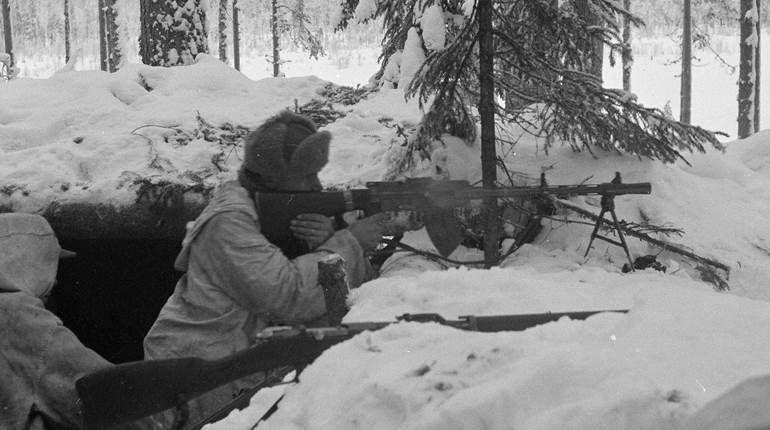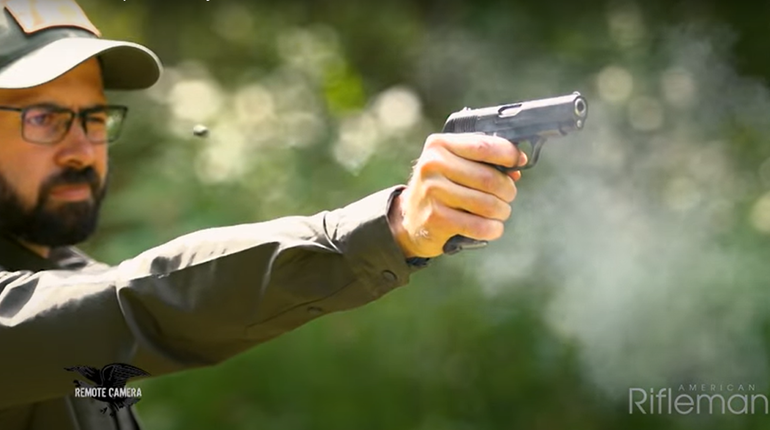The popularized narrative about the French Chauchat light machine gun is one that presents the automatic rifle as an unmitigated failure. Detractors tend to emphasize poor workmanship, delicate magazines, and they also regularly repeat the broadest possible generalization of all—that the Chauchat was prone to jamming. The origins of this mythology is a topic well covered in the book Honour Bound: Chauchat Machine Rifle by Yves Buffetaut and Gerard Demaison, as well as in Tom Laemlein’s 2012 article That "Damned, Jammed Chauchat."
A U.S. Army soldier fighting from behind a barricade made of sandbags and ammunition boxes with a Fusil Mitrailleur Modéle 1915 CSRG Chauchat Light Machine Gun on the western front during World War I. This model of Chauchat was chambered for the French 8x50R Lebel cartridge. (National Archives)
Despite its reputation, the "Fusil Mitrailleur Modéle 1915 CSRG" served effectively in combat for the French military chambered for the 8x50R Lebel cartridge, the Belgian military in 7.65x53 mm, and the Polish military in 7.92x57 mm Mauser. It was when the Chauchat was redesigned for the U.S. military in .30-'06 Sprg. as the Model 1918 that the real problems were encountered. This modification of the existing design required a different magazine, a modified magazine well, and a relocated foregrip. It retained the original’s long-stroke recoil-operating system, which was largely based on John Browning’s patented design for the Remington Model 8 autoloading rifle. But the chambers in the .30-cal. Chauchat Model 1918 were not reamed deeply enough, and the guns experienced failures as a result. Nevertheless, the American Expeditionary Force made extensive use of Model 1915 CSRGs in 8 mm Lebel during the First World War. In fact, three U.S. Army soldiers earned the Medal of Honor during the Meuse-Argonne Offensive using the Chauchat—Pvt. Frank J. Bart from C Company, 9th Infantry Regiment, 2nd Infantry Division, Pvt. Thomas C. Neibaur from M Company, 167th Infantry Regiment, 42nd Infantry Division, and Pvt. Nels T. Wold from I Company, 138th Infantry Regiment, 35th Infantry Division. You can read their citations below.
An old French couple, M. and Mme. Baloux of Brieulles-sur-Bar, France, under German occupation for four years, greeting soldiers of the 308th and 166th Infantries upon their arrival during the American advance. (National Archives)
Because it was produced in greater numbers than any other automatic weapon during World War I, the Chauchat remained in abundant supply during the years that followed 1918. Eventually, the military forces of 11 countries used it—including Nazi Germany. When the Third Reich invaded Poland in 1939, Belgium and France in 1940, and Greece in 1941, thousands of serviceable Chauchat light machine guns were captured and placed in service. The French Model 1915 in 8 mm Lebel was designated LeMG.156(f), the Belgian Model 1915 in 7.65 mm was designated LeMG.126(b). Greek, Yugoslavian and Polish examples were similarly type-designated by the Germans as well.
A posed photograph of a U.S. Army soldier armed with a Model 1911 .45-ACP pistol. On the ground next to him is a Fusil Mitrailleur Modéle 1915 CSRG Chauchat Light Machine Gun in 8x50R Lebel.
German ϟϟ troops armed with a captured French Fusil Mitrailleur Modéle 1915 CSRG Chauchat Light Machine Gun in 8x50R Lebel.
In the aftermath of its military service, the Chauchat went on to a second career as a collectible firearm in the United States. Thousands of Chauchats came into the country in a frenzy in the late 1950s as DEWATs—deactivated war trophies—many of which were subsequently reactivated and added to the National Firearms Act registry. Almost none of these registered/transferable guns are of the Model 1918 in .30-'06 but rather the Model 1915 produced by SIDARME in 8 mm Lebel. One of these made a recent appearance on the set during location shooting for the upcoming season of American Rifleman TV. In observation of the centennial of U.S. intervention in World War I, the show will broadcast a series of episodes featuring the guns that fought in the trenches of the Western Front, and the Chauchat is definitely one not to be overlooked. Almost in spite of its reputation, the gun we had on set that day ran surprisingly well on Prvi Partizan 200-gr. FMJ BT 8x50R. It did encounter stoppages, but in an unexpected twist, fewer than the .30-cal. Lewis gun that was on set at the same time. Magazine loading is a delicate operation with the Chauchat because the cartridges must be perfectly aligned in order for the gun to feed reliably. Considering that Chauchat magazines were originally conceived as being disposable items, it is rather astonishing that one still functions at all 100 years later. As can be seen in the video, a pattern of spent casings falling close to the breech during ejection was followed by a stovepipe at one minute and twelve seconds. This type of stoppage happened a few times during the day, but after a few adjustments the weak ejection was resolved by simply tightening the gun’s bouchon d’appui (Support Cap/Rear assembly collar) and bague d’appui (Support Ring) assembly. Once that was done and the magazines were loaded correctly, this Chauchat ran reliably.

The French Fusil Mitrailleur Modéle 1915 CSRG Chauchat Light Machine Gun in 8x50R Lebel and the detachable 20-round box magazine for the Chauchat that was used in a recent taping of the upcoming season of American Rifleman TV.
Despite the fact it served effectively during two World Wars and five other conflicts, the Chauchat remains a deeply misunderstood military firearm. It frequently ranks as number one in just about every “worst guns ever” list on the internet, but to criticize it in this way is to misunderstand it fundamentally. Referring to the Chauchat as "the worst gun ever" would be the same as referring to the Model T Ford as the worst car ever or the Wright 1903 Flyer as the worst airplane ever. When the Chauchat was introduced in 1915, there was nothing else like it in the world. In that way, it holds a unique and important place in the history of small arms. At a time when the Browning Automatic Rifle was not yet in full scale production and the Lewis Gun was much more expensive and nearly 10 pounds heavier, the Chauchat provided a light machine gun that could move forward on the battlefield with an attacking echelon. Its design drew inspiration from a John Browning patent and it was in full-scale production at a time when nothing else like it was. Although it might be easy to criticize the Chauchat here in the 21st Century, 100 years ago during the 20th the exigencies of wartime necessity made it the right gun at the right place at the right time. There are still voices pointing out its shortcomings even though, after more than a century, the gun can still turn in a good day’s work. That was certainly our experience on the set of American Rifleman TV. 
A rare example of the .30-caliber Fusil Mitrailleur Modéle 1918 CSRG Chauchat Light Machine Gun. (Photograph courtesy of James D. Julia Auctioneers)
Pvt. Frank J. Bart
C Company, 9th Infantry Regiment, 2nd Infantry Division
Pvt. Bart, being on duty as a company runner, when the advance was held up by machine-gun fire, voluntarily picked up an automatic rifle, ran out ahead of the line, and silenced a hostile machine-gun nest, killing the German gunners. The advance then continued, and when it was again hindered shortly afterward by another machine-gun nest, this courageous soldier repeated his bold exploit by putting the second machine gun out of action.
Pvt. Thomas C. Neibaur
M Company, 167th Infantry Regiment, 42nd Infantry Division
On the afternoon of 16 October 1918, when the Cote-de-Chatillion had just been gained after bitter fighting and the summit of that strong bulwark in the Kriemhilde Stellung was being organized, Pvt. Neibaur was sent out on patrol with his automatic rifle squad to enfilade enemy machine-gun nests. As he gained the ridge, he set up his automatic rifle and was directly thereafter wounded in both legs by fire from a hostile machine gun on his flank. The advance wave of the enemy troops, counterattacking, had about gained the ridge, and although practically cut off and surrounded, the remainder of his detachment being killed or wounded, this gallant soldier kept his automatic rifle in operation to such effect that by his own efforts and by fire from the skirmish line of his company, at least 100 yards in his rear, the attack was checked. The enemy wave being halted and lying prone, four of the enemy attacked Pvt. Neibaur at close quarters. These he killed. He then moved alone among the enemy lying on the ground about him, in the midst of the fire from his own lines, and by coolness and gallantry captured 11 prisoners at the point of his pistol and, although painfully wounded, brought them back to our lines. The counterattack in full force was arrested to a large extent by the single efforts of this soldier, whose heroic exploits took place against the skyline in full view of his entire battalion.
Pvt. Nels T. Wold
I Company, 138th Infantry Regiment, 35th Infantry Division
He rendered most gallant service in aiding the advance of his company, which had been held up by machine-gun nests, advancing, with one other soldier, and silencing the guns, bringing with him, upon his return, 11 prisoners. Later the same day he jumped from a trench and rescued a comrade who was about to be shot by a German officer, killing the officer during the exploit. His actions were entirely voluntary, and it was while attempting to rush a 5th machine-gun nest that he was killed. The advance of his company was mainly due to his great courage and devotion to duty.
























